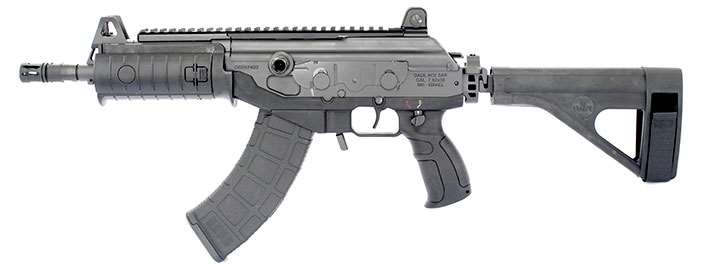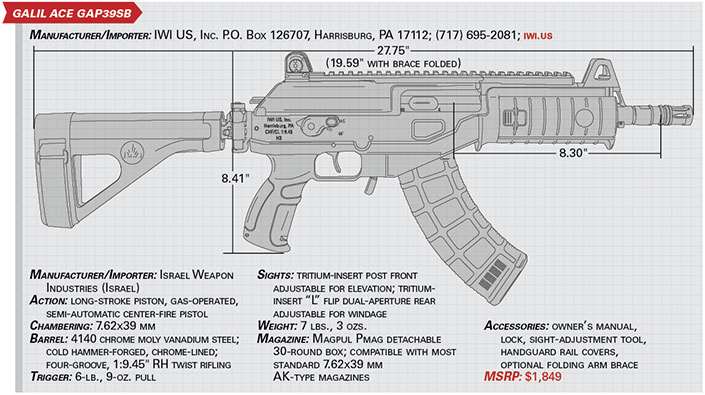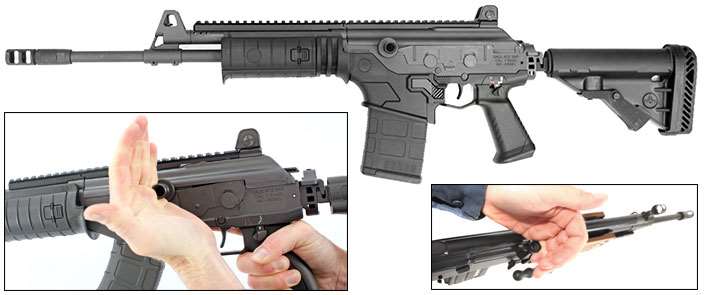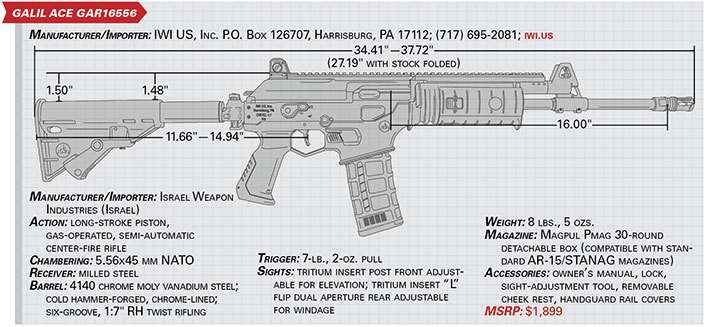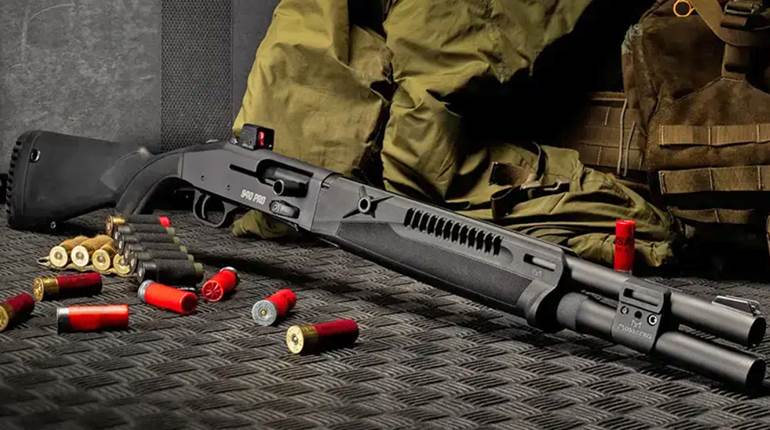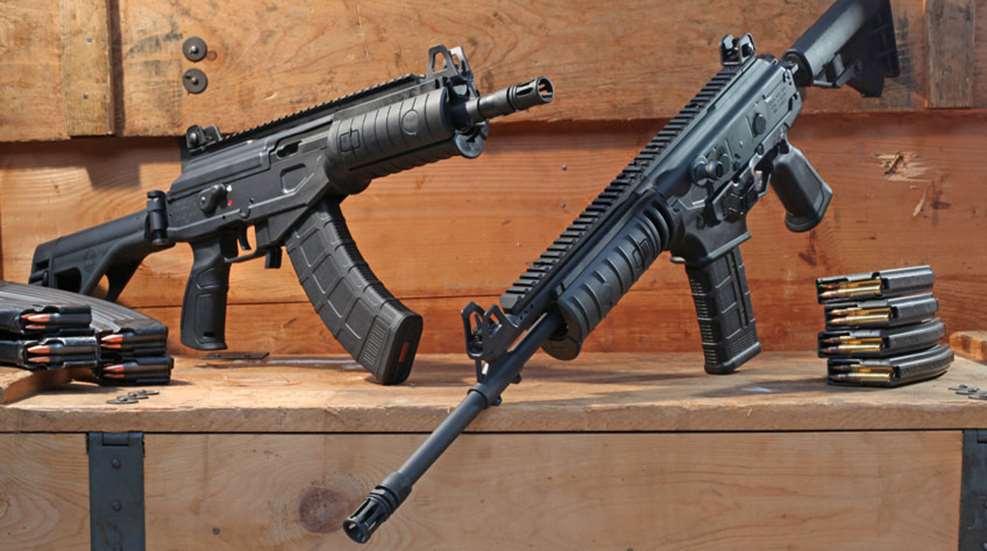
With an appearance unlike any before them, IWI’s Galil ACE GAP39SB pistol (l.) in 7.62x39 mm and its Galil Ace GAR16556 in 5.56x45 mm NATO represent the current “state of the art” in semi-automatic AK-based firearms.
The fall of the Berlin Wall ushered in a new era of military small arms design that saw many of the firearms that had arisen from the ashes of World War II relegated to the dust bin, but over and over, nations have chosen to update and stay with their Kalashnikov-based service rifles. The Russian military recently accepted the AK-12, a variant of its AK-74. Likewise, their neighbors, the Finns, have announced that, with cosmetic upgrades, they plan to have their 1960s-era AK rifles soldier on for another 20 years. Many former Warsaw Pact countries, from Poland to Hungary, have done the same. These rifles have been modified for 21st century tastes—there are rails for optics and accessories, ergonomic stocks and grips, and the extensive use of polymer—but at their heart is still the gas-operated, long-stroke-piston, rotating-bolt design that Mikhail Kalashnikov began to pen in the waning days of World War II.
One of the most successful of these “modernized” Kalashnikovs comes from outside the former Iron Curtain. Israel adopted its AK-derived Galil rifle in the early 1970s. While always overshadowed in Israeli service by the M16, and eventually supplanted by the Tavor bullpup, the Galil has been given a new lease on life. The recently introduced ACE version of the Galil promises to keep the Kalashnikov design relevant for some time.
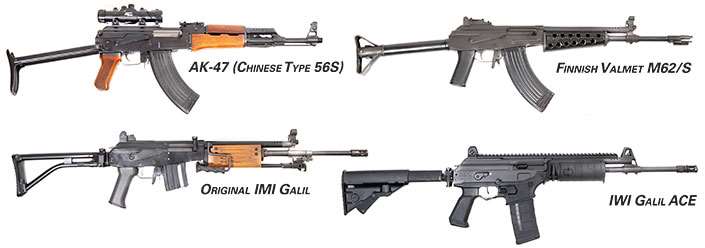
Adoption
When it was founded in 1948, the nation of Israel armed its military forces with a mixture of World War II surplus British, American and German guns. It worked quickly to standardize its small arms inventory and develop indigenous designs that could be produced domestically. The first of these was the famous Uzi submachine gun.
In 1955, the Israel Defense Force (IDF) adopted the Belgian FN FAL as its standard infantry rifle, along with a heavy-barreled FAL for use in a squad automatic role. By the late 1960s, the Israelis were learning the same lesson that the American military was experiencing in Vietnam. A large, heavy, full-power battle rifle (the Israeli-version of the FAL weighed nearly 10 lbs. and was 43" overall) was less than ideal for mechanized, urban and asymmetric warfare. Following the 1967 Six-Day War, the Israelis sought a more compact rifle that fired an intermediate cartridge that would allow for controllable full-automatic fire.
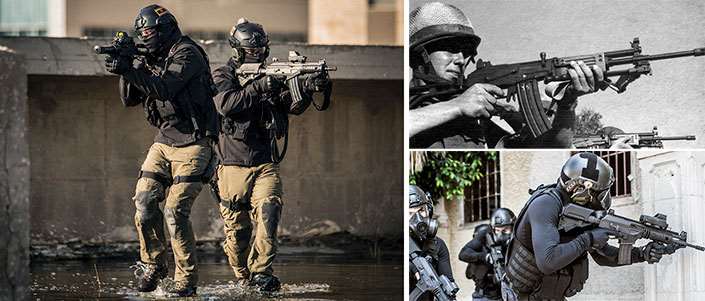
To select a new service arm, the Israelis held a trial that tested most of the contemporary 5.56x45 mm designs, including the M16, HK33, AR-18 and the Stoner 63, along with the 7.62x39 mm AK. It also tested two native designs, one by Uziel Gal, the designer of the Uzi, and another by Israel Military Industries (IMI) designer Yisreal Galil. Galil’s rifle came out on top.
The core of the Galil design was the AK-47, a rifle that the IDF had seen frequently used by opposition forces for more than a decade. While the basic long-stroke-piston, rotating-bolt design of the Soviet rifle was utilized, many of the Galil’s external features came from a more refined version of the AK, the Finnish Rk 62.
In the 20th century, Finland looked to its neighbor, and sometimes enemy, the U.S.S.R. for small arms designs. The Finnish military used variants of the Mosin-Nagant, often building them from captured Russian arms. When the Finns sought to update their infantry rifles in the 1950s, they naturally built upon the basic architecture of the Soviet Kalashnikov. The resulting rifle, which they adopted as the Rk 62, used a robust receiver milled out of a solid block of steel, like early AKs, rather than the stamped receiver of the later AKM. The rear sight, which is mounted on a block pinned to the barrel on the AK, was moved to the rear of the receiver cover for a longer eye relief and to allow the use of an aperture. Since this block is also where the AK’s gas tube mounts, on the Rk 62 the tube is attached directly to the receiver.
The Galil followed the Rk 62 in using a milled receiver with a rear aperture sight mounted on the receiver cover. In fact, the first Galils were manufactured using Valmet Rk 62 receivers. In addition to the AK-type, right-side dustcover/selector lever, the Galil added a thumb-operated safety selector on the left side of the pistol grip. In another nod to the ambidextrous use of controls, the charging handle angled up and extended above the receiver cover so that it could be used with either hand, much like the charging handle of the Uzi. A 35-round magazine was adapted from the Stoner 63. To make for a more compact package, the Galil had a side-folding stock that mimicked the paratrooper version of the FAL. Though still 39" overall, folding its stock reduced the Galil to 30" in length.

Like the FAL, the Israelis sought to make the Galil design the basis of a firearm “system.” It was made in both infantry rifle (AR—“Assault Rifle”) and light machine gun (ARM—“Assault Rifle/Machine gun”) models. The ARM had a carrying handle, bipod and special 50-round magazine, and weighed in at nearly 10 lbs. It included two unique features. A wire cutter was integrated into the bipod and a bottle opener built into the handguard (allegedly to keep Israeli soldiers from prying off bottle caps with the feed lips of their magazines).
IMI later produced the “Short Assault Rifle” (SAR) with a 13" barrel and an 8"-barreled “Micro Assault Rifle” (MAR) version of the Galil. A 7.62x51 mm NATO Galil was introduced for the export market and was later modified into a semi-automatic-only designated marksman rifle used by the IDF, known as the “Galatz.” In the 1990s, the 5.56x45 mm NATO Galil was also modified into a marksman’s rifle, rounding out an entire system comprised of a compact assault rifle, infantry rifle, light machine gun and precision rifle.
Manufacture of the Galil began in 1971, and the rifle was officially adopted by the IDF in 1972. Though it was the IDF’s official service rifle, production of the Galil could not keep up with the copious quantities of M16s supplied by the United States, and the American rifle became the IDF’s primary arm.
The Galil made a bigger impact outside of Israel. It was adopted by numerous countries around the world, most notably in Central and South America and Africa. The South Africans produced their own variation of the Galil, which they called the R4.
Commercialization
In the late 1970s, Magnum Research began importing semi-automatic-only versions of the Galil rifle into the United States in both ARM and AR form and 5.56 mm and 7.62 mm NATO chamberings. Action Arms would later take over Galil importation until the model was banned by name in 1989. Among the products that Action Arms imported was the “Hadar II” a 10-lb., 8-oz. hunting version of the .308 Win. Galil with a full wood stock. A ban-compliant, thumbhole stock-equipped rifle, called the “Galil Sporter,” was sold from 1991-1993. In total, less than 10,000 original IMI-produced semi-automatic Galils were imported into the country.
Uzi America, a subsidiary of Mossberg, continued to import Galils and other IMI products for law enforcement sales between 1994 and 1997. Around that same time, Galil production was ending in Israel. By the early 2000s both the Galil and M16 rifles were being replaced in Israeli service by the Tavor bullpup.
In 2005, the government-run IMI was privatized, with Israel Weapon Industries (IWI) taking over firearm production. Among its first tasks was to resurrect the Galil. The result was called the “ACE,” and it sought to modernize the platform by remedying what some saw as drawbacks of the original design.
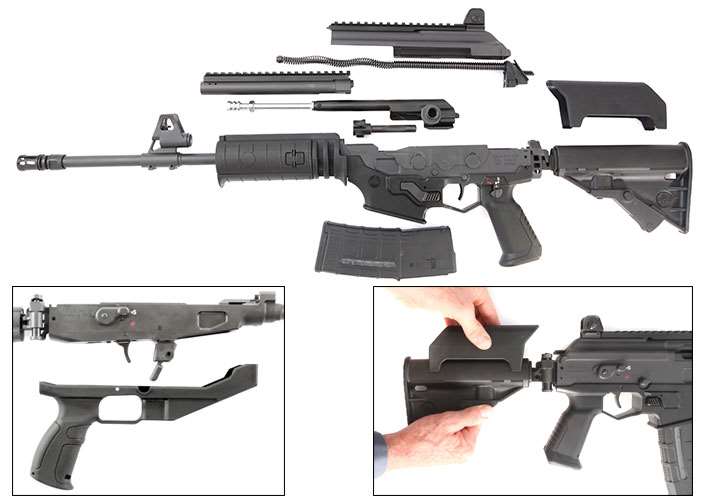
At first glance, the main difference between the original Galil and the ACE is the use of polymer in the area of the receiver. Some misunderstanding has occurred over the ACE’s receiver design. Though sometimes described as a metal/plastic hybrid with an “upper” and a “lower,” in reality the ACE uses a conventional milled AK-type receiver that contains the rifle’s operating system. To it is mated a polymer housing with an integral pistol grip, trigger guard and magazine well.
While much has been made of the ACE’s weight savings (a common complaint against the original Galil was its heft) the reality is that the ACE’s milled receiver is only slightly slimmer than its parent, and the only metal component that has been replaced by polymer is the trigger guard. Still, the ACE shaves about three quarters of a pound off the weight of the original Galil AR model.
What the polymer lower housing does is allow the same basic ACE receiver to be adapted to three different cartridges and five different magazine types. IWI offers the Galil ACE in 7.62x51 mm NATO, 7.62x39 mm and 5.56x45 mm NATO. The 7.62 mm NATO version uses original Galil magazines in that chambering, and the 7.62x39 mm uses standard AK magazines. There are two versions of the 5.56 mm NATO ACE. One uses the original Galil 5.56 mm magazine, and the other the M16/AR-15 magazine. With cartridge, barrel length and magazine options, a total of 11 military variants of the ACE are being produced.
In one of the most radical departures of the ACE from the traditional AK/Galil design, the rifle returns to its Sturmgewehr roots with the charging handle moved to the left side. Unlike a traditional AK, whose charging handle slot is opened when the safety is off, a spring-loaded dustcover on the ACE is pushed out of place and then returns to cover the reciprocating charging handle’s slot as each round is fired. IWI calls the action “sealed.”
Spring-loaded dustcovers of this type are used on the FN FNC rifle and M249 Squad Automatic Weapon, but again, ACE designers may have looked north for inspiration. A prototype Finish Rk made in the early 1990s used a similar spring-loaded dustcover arrangement, and the feature later showed up on the Micro Galil at the end of its production run.
The ACE sought to modernize the Galil platform in other areas as well. MIL-STD-1913 Picatinny optics rails were added to the gas tube and the dustcover. The polymer handguard has rail segments in the 3-, 6- and 9-o’clock positions, with removable covers supplied to protect them when not in use. A telescoping M4-style stock allows for an adjustable length of pull in six positions, and the pistol grip is an ergonomic design in the pattern of those offered by Israeli accessories manufacturer FAB Defense. The 5.56 mm NATO versions of the ACE feature a bolt hold-open device that locks the bolt to the rear after the last round is fired, one of the first times this feature has been offered on a factory-produced AK.
The diversity of the ACE line-up shows IWI’s understanding of the contemporary military small arms market. Its chambering in 7.62x39 mm, and use of standard AK magazines, allows countries to replace aging Soviet and Eastern European inventories with a modern rifle that is compatible with their existing magazine and ammunition stockpiles. Those already using the original Galil get an updated version of the rifle with which they are already familiar. For countries wanting to be NATO-complaint, yet still use a Kalashnikov design, the 5.56 mm N (“NATO”) model ACE uses NATO-standard magazines in an AK platform.
Importation
In 2015, IWI US, Inc., announced that it would begin selling the Galil ACE, adding that design to complement its line of Tavor bullpup rifles. All three chamberings would be available in both rifle and pistol configurations (with or without an arm brace) for a total of nine different models. ACE rifles and pistols are assembled at IWI US’s Harrisburg, Pa., facility from both Israeli and American-made parts. Rifles must comply with the provisions of 18 U.S.C. § 922(r). The first ACE firearms, 7.62x39 mm rifles, were on dealers’ shelves in July 2016. As of mid-year 2017, all nine ACE models were available.
To evaluate the ACE lineup, I tested a 5.56 mm NATO rifle (GAR16556) and a 7.62x39 mm pistol equipped with an arm brace (GAP39SB). IWI US’s ACE models have some distinctive features from their military counterparts. Starting at the business end, the ACEs’ chrome-lined, cold hammer-forged barrels have their muzzles threaded 1/2x28 TPI for the 5.56 mm NATO models and 5/8x24 TPI for the .30-cal. models, making them compatible with the immense aftermarket of muzzle brakes. The supplied muzzle device is an A2-type, five-slot arrangement for the 5.56x45 mm NATO and 7.62x39 mm models, and a unique two-chamber compensator on the 7.62x51 mm NATO ACEs.
U.S. ACE models use three types of magazines. Those in 7.62x39 mm use AK magazines, 5.56 mm NATO firearms use AR-15 magazines and, unique to the U.S. market, 7.62x51 mm NATO ACEs use SR-25/AR-10-type magazines. All U.S. ACEs ship with Magpul PMAGs.
There are two important notes regarding magazines. First, to maintain 922(r) compliance, ACE rifles must use U.S.-made magazines (the magazine counts for three parts in the firearm’s U.S. parts count). This is no problem for the 5.56 mm and 7.62 mm NATO models, but owners of 7.62x39 mm rifles need to avoid the prolific overseas-produced magazines. Second, those interested in 7.62x39 mm ACE models should also note the ACE’s plastic magwell precludes the use of drum magazines and is too narrow to accept some polymer magazine designs.
Also unique to the American ACE lineup is a folding stock. Along with the telescoping design (which is proprietary and not compatible with M4/AR-15-type stocks) rifle stocks and pistol braces fold to the right side. The firearms are fully functional and can be fired when folded.
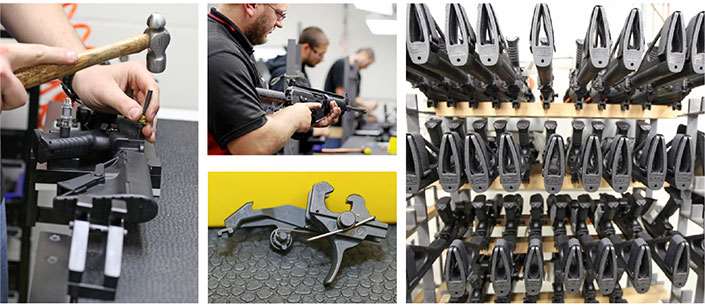
Evaluation
Like the original Galil, the ACE is designed to be bilateral in operation. The paddle-type magazine release can be operated by the thumb of either hand with the 7.62x39 mm firearms. ACEs in 5.56x45 mm NATO and 7.62x51 mm NATO have bilateral button magazine releases. Safety selectors are located on both sides of the firearms, but are in slightly different locations for use by a right-handed shooter’s thumb and forefinger. For those used to a standard AK-type safety, the right hand can still sweep the ACE’s selector on and off. One advantage of the ACE’s safety is that, unlike a traditional AK with a dustcover selector, the ACE can be unloaded with the safety on.
The left-side charging handle of the ACE means that a right-handed shooter can work the action using his or her weak hand while maintaining a firing grip. Left handers have to do what right-handed AK shooters have been doing for years—cant the firearm and reach over or under the receiver to grab the charging handle. The bolt release on 5.56 mm NATO ACEs can be reached by the index finger of the strong hand for a right-handed shooter. A southpaw can catch the release with his or her thumb when loading a fresh magazine or bump the charging handle to send the bolt into battery.
At the range, the ACE does not yield the typical AK shooting experience—and that is for the better. IWI has put much effort into the ACE’s trigger. While AK-style rifles are notorious for poor trigger pulls, the ACE features a two-stage unit taken from the Galatz sniper.
The optics rail runs continuously from the front sight base to the rear sight, and a removable cheek rest raises the shooter’s line of sight for use with optics. Although it attached in a more secure manner than a standard AK receiver cover optics mount, the ACE’s cover still has a slight amount of play. It’s not enough to matter at close range; but as the distance stretches out, its effect becomes apparent. The ACE’s supplied iron sights feature a tritium post front with an aperture rear indexed by two tritium dots for night sight capability.
I tried a variety of magazines in our test ACEs, from the supplied Magpuls to commercial and military surplus devices of varying capacity. With the expectations mentioned above for 7.62x39 mm models all of the magazines we tried fit and fed properly.
Both rifle and pistol functioned flawlessly through the hundreds of rounds, but my range testing pales in comparison to what IWI has put its ACE lineup through. In fact, the company’s website is full of torture test videos, ACEs dunked in water or covered in mud and sand then put through their paces.
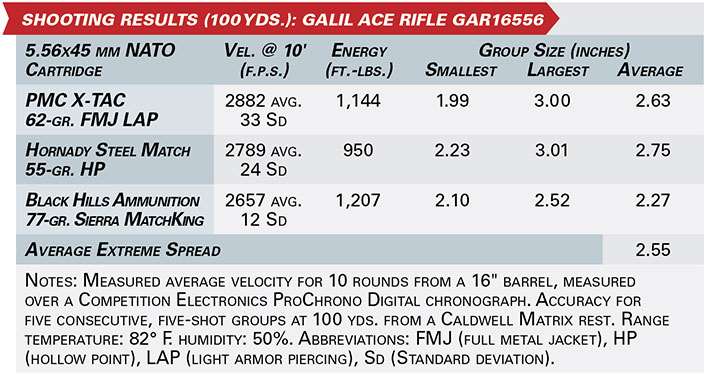
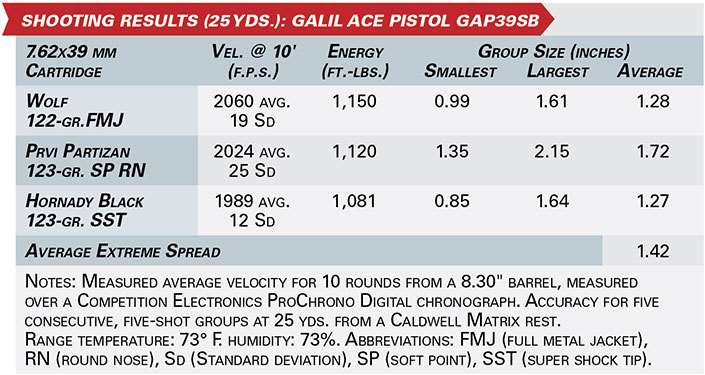
What is the Galil ACE’s place in the modern sporting rifle market? For those looking for the robustness of the Kalashnikov design with the refinements of the AR-15, the 5.56x45 mm NATO ACE checks all the boxes—the safety selector is familiarly at the right thumb, the stock is adjustable, it uses AR magazines and has a bolt hold-open device. Likewise the 7.62x51 mm NATO ACE is a viable AR-10/SCAR 17 alternative.
The 7.62x39 mm ACE offers a Kalashnikov with the refinements usually only found on custom-built AKs—left-side charging handle, magazine well, optics rail, aperture rear sight, telescoping stock and railed handguard. The 7.62x39 mm models are also a .300 Blackout alternative, especially in pistol form.
Horizon
Not the official rifle of the IDF, the ACE, like the original Galil, has made its biggest impact outside of Israel. The military version of the rifle has been adopted by Chile, Vietnam, Colombia, Peru and Estonia, and it has been licensed for manufacture in those countries. With the ACE in the running to be the next service rifle in places such as India and Pakistan, its adoption in those nations could make it one of the most prolific modern AK designs.
In little more than a year, sales of the Galil ACE in the United States have already matched the number of original Galils sold here during its decade-long run in the 1980s. American Galil aficionados can expect more to come. Then-vice president of sales and marketing of IWI US, Michael Kassnar, implied that the Kalashnikov’s evolution through the Galil line is not yet finished. “The IWI motto is ‘Innovate, Optimize, Perform,’” he said. “IWI in Israel never stops looking for ways to make a platform better.”
Whatever the future holds for IWI’s ACE, the AK—especially in its Galil form—is here to stay.
